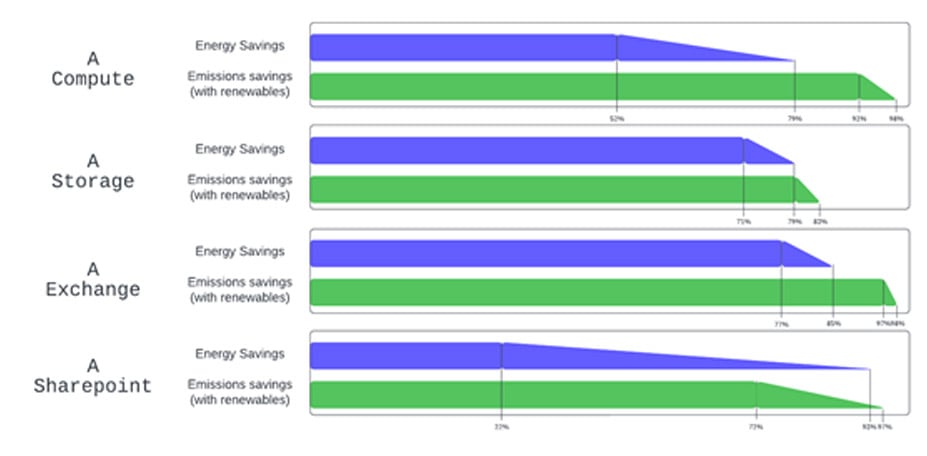Reading Time
6 min
Sustainability has become an important issue among software and hardware developers, even for small businesses. Additionally, customers have become increasingly concerned about companies' sustainability levels over the past two decades due to the rise in global power usage. Researchers have explored the superiority of Information and Communication Technologies (ICT) over the environment throughout its lifecycle to highlight the importance of green and sustainable cloud systems. However, even the fastest transition from local systems to green cloud systems may not solve current environmental issues. On the other hand, increased computer usage worldwide continues to pose energy-related harm.

This study demonstrates how research shows the impact of green cloud systems on sustainability and energy usage.
Green cloud systems refer to environmentally friendly cloud systems that utilize renewable energy sources and implement energy-efficient technologies. Recent research has shown that green cloud systems significantly reduce energy consumption and carbon emissions compared to previous cloud system technologies. Additionally, the adoption of green cloud systems can lead to a significant increase in sustainability within a company. Furthermore, there is a positive relationship between the adoption of green cloud systems and a company's commitment to sustainability.
In assessing the issue, some organizations list solutions for worst-case scenarios regarding energy consumption. According to them, some solutions include:
As we can see in the third solution, Puget Sound University recommends the use of virtual technologies to support reducing energy consumption and sustainability, among other significant advantages.

Some benefits of Green Cloud Systems include:
On the other hand, there are very few challenges to be addressed during the implementation of the environmentally friendly Green Cloud System. These include:
Studies on Energy Consumption and Emissions
In 2018, a global cloud service provider (referred to as "Brand A" in our study) conducted research on the carbon benefits of Cloud Computing within its own Cloud systems. An overview of the study showed that cloud solutions offered up to 93% greater energy efficiency and up to 98% greater carbon efficiency compared to on-premises solutions. To be more specific, this global cloud service provider compared the concrete greenhouse gas emissions among four different cloud computing solutions with on-premises IT and data storage solutions.
A Computing and A Storage Solutions were included in the comparison. Thus, the efficiency of A Solutions, which proved to be one of the best and most efficient systems, was demonstrated.

In Figure 1.1, you can clearly see the range of energy and emission savings according to cloud services. "Energy Savings" indicates the energy savings in data center electricity used in global brand Cloud services compared to in-house equivalents. "Emission Savings (with renewable sources)" demonstrates the emission savings of global brand Cloud services compared to in-house equivalents, considering the purchase of zero-emission renewable electricity to power global brand Cloud systems.
As a result, it is evident that cloud computing can increase a business's energy efficiency by anywhere from 22% to 93%. Much of this increase in emission reductions was achieved through the reduction of electricity consumption via data centers operating in the cloud. Improvements in IT operational efficiency, equipment efficiency, and data center infrastructure efficiency have contributed significantly to the reduction in energy usage and carbon footprint. Additionally, an improvement was made by the global brand purchasing renewable electricity consumed by its data centers directly.

Another study by AT&T identifies the Carbon Disclosure Project among eleven companies using cloud systems. Additionally, it determined that transitioning an "human resources (HR) application from a private IT application for a typical food and beverage company" to a public cloud system could reduce CO2 emissions by 30,000 metric tons over five years, roughly equivalent to 5,900 passenger vehicles. Using an internal cloud instead of a public cloud could reduce the footprint by 25,000 metric tons over five years or approximately 4,900 passenger vehicles.
From a general perspective, this study clearly demonstrates that the implementation of green cloud systems could have a tremendous impact on energy consumption and sustainability. The use of renewable energy sources and energy-efficient technologies in green cloud systems leads to a reduction in carbon emissions, and energy consumption varies compared to previous cloud system methods. Another assumption derived from this study is that cloud systems could lead to an average increase in sustainability among companies. Consequently, the importance of green cloud systems as a means to reduce energy consumption and promote sustainability is emphasized.
Arda Hacıfevzioğlu
Maltepe University, Faculty of Engineering and Natural Sciences, Department of Computer Engineering
- Purchasing from Environmentally Conscious Companies
- Participation in Electronic Recycling Programs
- Deployment of Virtual Technologies
- First, minimized energy consumption. As we know, data centers consume tons of energy through physical servers, storage systems, network devices, cooling systems, etc.
- Server solutions aided by virtualization, which reduces the number of physical servers.
- Automation, orchestration, and dynamic provisioning help prevent wasted energy and storage space.
- Utilizing certain tools for cooling systems, etc., to minimize greenhouse gas emissions.
- Preferring renewable energy sources; using renewable sources such as solar power plants and wind to generate energy and preserve the environment.
- Location of Data Centers: Managers must choose highly efficient locations for data centers as the availability of energy is crucial. Additionally, managers may need to select Special Economic Zones (SEZs) as the location for data centers, which should be close to wind energy production areas and solar panels.
- Cooling: Cooling has been one of the biggest challenges that computer manufacturers in the industry have been grappling with for years. Given the large number of computers in data centers, cooling becomes the most significant obstacle in this area. According to recent research, cooling accounts for one-third of the energy consumption in data centers. Engineers typically use five different cooling techniques for these systems: Free Cooling, Evaporative Cooling, Liquid Cooling, Immersion Cooling, and Raised Floor techniques.
- Storage: This issue, which comes as one of the biggest challenges in the IT sector, involves data centers known as "Datacenters," which store data for companies and use a large number of disks, significantly increasing energy consumption.
- E-Waste: Most companies use nuclear, electricity, and coal energy sources, which are extremely harmful to nature.


